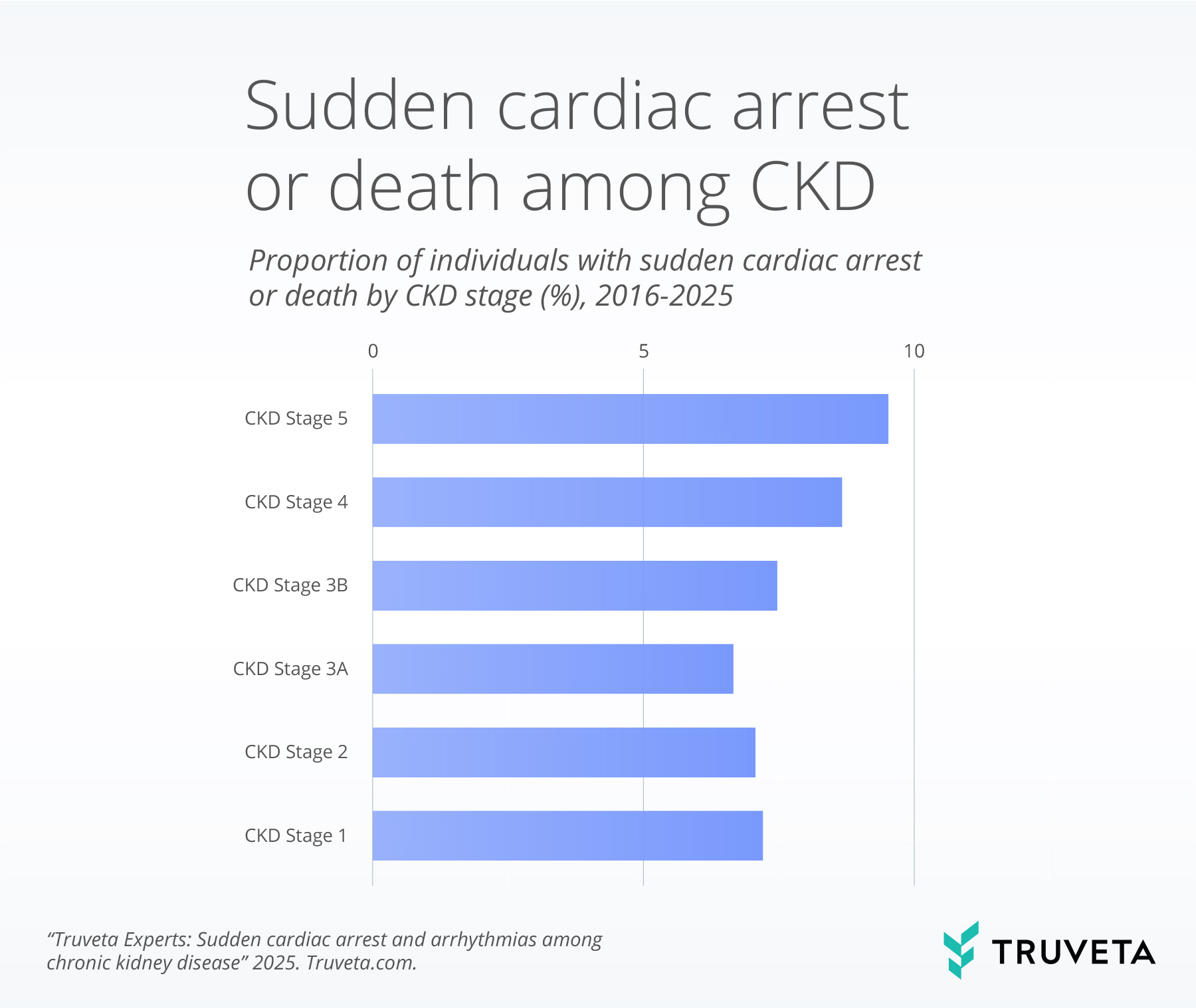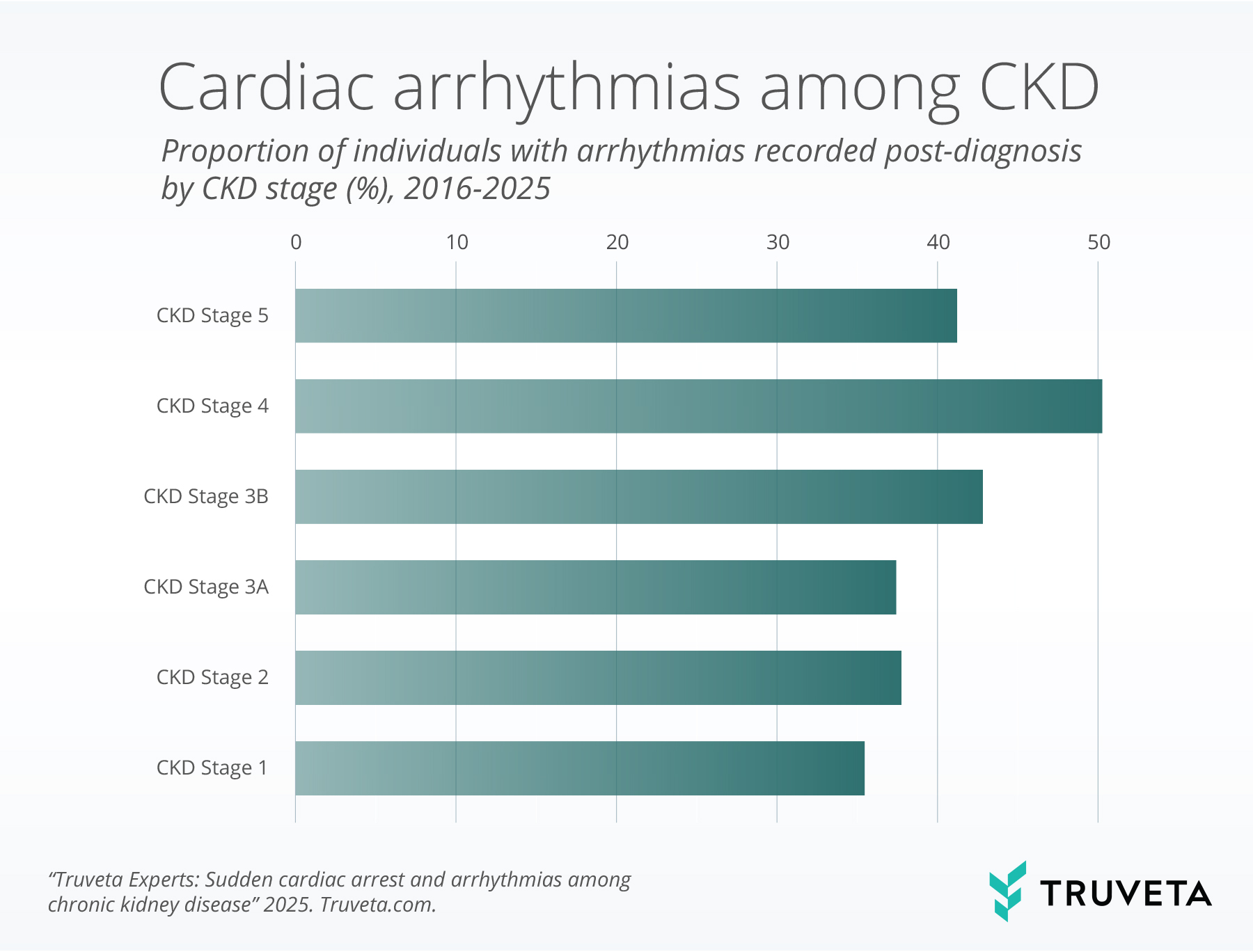In this edition of Truveta experts, Esther Kim, PhD, MPH, Senior Director of Research Services at Truveta, shares findings from her recent exploration of the burden of sudden cardiac arrest (SCA) or sudden cardiac death (SCD), as well as cardiac arrhythmias, among patients with chronic kidney disease (CKD).
Esther brings a deep background in epidemiology and real-world evidence, including published work focused on CKD and its association with SCD and atrial fibrillation. In this spotlight, she draws on both past academic work and new analyses conducted with Truveta Data to explore the comorbidity burden of serious heart rhythm disorders—including cardiac arrhythmias and sudden cardiac death—which have an alarmingly high rate among individuals with CKD.
Why it matters: Cardiac risk in CKD
CKD affects 10–15% of the global adult population and significantly increases the risk of cardiovascular disease—the leading cause of death in this group. Among these risks, sudden cardiac death (SCD)—often caused by cardiac arrhythmias—is a major contributor to mortality. In end-stage renal disease (ESRD), SCD accounts for up to 25% of all deaths.
Previous studies on the burden of cardiac arrhythmias and SCD or SCA in patients with CKD have focused on the ESRD or dialysis population, so there is limited knowledge on the burden of arrhythmias, SCA, and SCD across the full spectrum of CKD in a large, nationally representative population, especially using real-world data. Using Truveta Data allows us to investigate the real-world burden of cardiac arrhythmias, SCA, and SCD among CKD.
Understanding this burden can help strategize effective prevention and management among individuals with CKD.
Methods
This analysis identified 5,223,466 patients who have been diagnosed with CKD stages 1-5 between January 1, 2016 and July 20, 2025. CKD stages 1-5 were defined using ICD-10-CM and SNOMED CT codes. Among these patients, the proportion of patients who have at least one record of cardiac arrhythmias after the first date of their CKD stage diagnosis was summarized by CKD stage. Similarly, the proportion of patients with recorded SCD or SCA was summarized by CKD stage. Cardiac arrhythmias, SCA, and SCD were defined using ICD-10-CM and SNOMED CT codes. Crude proportions were summarized; adjustments were not performed.
Results
Sudden cardiac arrest or death was the highest among CKD stage 5 (9.5%), and this burden seemed to increase with CKD severity.

The burden of cardiac arrhythmias was much higher and also seems to increase with CKD severity, which suggests that this may be associated with sudden cardiac arrest or death. Approximately 50% of individuals with CKD stage 4 experienced cardiac arrhythmia post-diagnosis, though the proportion was slightly lower among CKD stage 5 (42%).

Discussion
This analysis shows that CKD severity is correlated with increased burden of sudden cardiac arrest or death (SCA/D), with cardiac arrhythmias showing a similar trend. The highest arrhythmia burden was observed in CKD stage 4, suggesting that earlier intervention—before patients progress to end-stage disease—may offer the greatest preventive benefit. These findings reinforce the critical importance of monitoring and managing cardiac arrhythmia, SCA, and SCD risk across the CKD continuum, particularly in more advanced stages.
Limitations
The true burden of cardiac arrhythmias is difficult to study because arrhythmias are often transient and asymptomatic, and the current practice of capturing arrhythmias is limited by short periods of arrhythmia monitoring. As this analysis also relies on diagnostic codes to capture arrhythmias, this analysis may underrepresent the true burden of arrhythmias.
Future research
This initial analysis offers a foundational view of the burden of cardiac arrhythmias, sudden cardiac arrest (SCA), and sudden cardiac death (SCD) across CKD stages—but it opens the door to many important follow-up questions. With access to Truveta’s representative, complete, and timely patient journey data, future studies can:
- Explore temporal patterns: What is the timing and sequence between arrhythmias and SCA or SCD events?
- Differentiate arrhythmia subtypes: How does the burden vary by arrhythmia type (e.g., atrial fibrillation, ventricular tachycardia, AV block)?
- Investigate associated factors: What clinical, laboratory, or treatment variables—such as cardiovascular disease, electrolyte levels, or medication use—are associated with elevated risk?
Truveta’s ability to link de-identified EHR data—inclusive of diagnoses, vitals, labs, medications, and concepts extracted from unstructured clinical notes—with closed claims, mortality, and SDOH data enables researchers to address these questions with greater precision and scale than previously possible.
About Truveta experts
The Truveta experts series highlights insights from researchers, clinicians, and data scientists working across Truveta. Each post highlights how real-world data can unlock new understanding—from disease patterns to treatment complexity to population health trends.
Explore more in this series:
Treatment trends for trigeminal neuralgia
Fireworks during the fourth of July
Real-world trends in Rituxan biosimilar adoption
Sudden cardiac arrest and arrhythmias among patients with chronic kidney disease
Biomarker testing trends in metastatic non-small cell lung cancer
See how Truveta Data can accelerate your next study—Request a customized demo today
